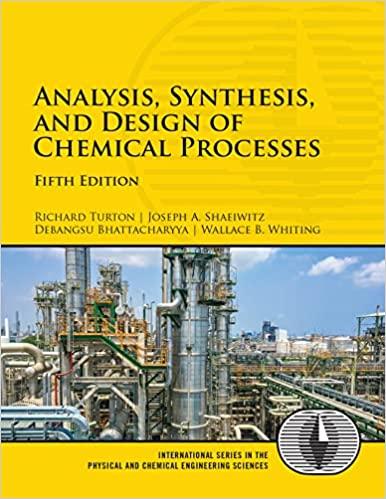In the production of an API (active pharmaceutical ingredient), the following batch recipe is used. Step 1:
Question:
In the production of an API (active pharmaceutical ingredient), the following batch recipe is used.
Step 1: 500 kg of reactant A (MW = 100 kg/kmol) is added to 5000 kg of a mixture of organic solvent (MW = 200 kg/kmol) containing 60% excess of a second reactant B (MW = 125 kg/kmol) in a jacketed reaction vessel (R-301), the reactor is sealed, and the mixture is stirred and heated (using steam in the jacket) until the temperature has risen to 95°C. The density of the reacting mixture is 875 kg/m3 (time taken = 1.5 h).
Step 2: Once the reaction mixture has reached 95°C, a solid catalyst is added, and reaction takes place while the batch of reactants is stirred. The required conversion is 94% (time taken = 2.0 h).
Step 3: The reaction mixture is drained from the reactor and passed through a filter screen (Sc-301) that removes the catalyst and stops any further reaction (time taken = 0.5 h).
Step 4: The reaction mixture (containing API, solvent, and unused reactants) is transferred to a distillation column, T-301, where it is distilled under vacuum. Virtually all of the unused reactants and approximately 50% of the solvent are removed as overhead product (time taken = 3.5 h). The end point for the distillation is when the solution remaining in the still contains less than 1 mol% of reactant B. This ensures that the crystallized API, produced in Step 5, meets specification.
Step 5: The material remaining in the still is pumped to a crystallizer, CR-301, where the mixture is cooled under vacuum and approximately 60% of the API from Step 2 crystallizes out (time taken = 2.0 h).
Step 6: The API is filtered from the crystallizer and placed in a tray dryer, TD-301, where any entrapped solvent is removed (time taken = 4 h).
Step 7: The dried API is sealed and packaged in a packing machine, PK-301, and sent to a warehouse for shipment to the customer (time taken = 1.0 h).
Perform a preliminary design on the required equipment items for this batch process.
Step by Step Answer:

Analysis Synthesis And Design Of Chemical Processes
ISBN: 9780134177403
5th Edition
Authors: Richard Turton, Joseph Shaeiwitz, Debangsu Bhattacharyya, Wallace Whiting





